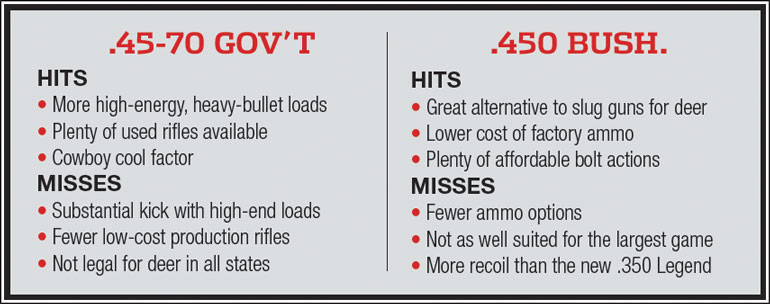
That the .45-70 stills warrants discussion as a modern sporting round is something of a miracle. After all, this straight-wall cartridge was originally designed to be used with blackpowder propellants in 1873 and somehow survived the advent of bottleneck cartridges and smokeless powder.
The .45-70 has benefited from technological advancements over its long lifespan. Modern actions like the Ruger No. 1 and the Marlin 1895 can handle higher pressures than the bygone 1873 Trapdoor Springfields, and the current selection of advanced smokeless powders and quality bullets allow modern hunters to do things with the .45-70 that shooters a few generations back couldn’t imagine.
Original Trapdoor loads generated muzzle velocities of roughly 1,600 fps and produced muzzle energies around 1,700 ft.-lbs. With modern guns and loads the .45-70 can surpass 2,200 fps with 350-grain bullets and generates well over 2.5 tons of muzzle energy.
The .450 Bushmaster is a product of more modern times. The cartridge was a joint development between Hornady and Bushmaster, and it was designed with a rebated rim that seats on the mouth of the cartridge. The .450 Bushmaster was designed to operate in AR-15 platform rifles and is capable of delivering considerably more close-range punch than the 5.56 NATO.
The Bushmaster got a major boost thanks to revised big game hunting laws in states like Michigan, Ohio and Indiana that allowed the use of straight-wall cartridges. The .450 offers better ballistics than rifled shotgun slugs, and bolt-action rifle manufacturers began pumping out affordable guns chambered for this round to meet the sudden demand for deer rifles.
It may seem that the .45-70 and .450 Bushmaster share almost nothing in common, and that’s pretty accurate. Even their .45 caliber bullets differ: The Bushmaster uses a .452-inch bullet while the .45-70 fires .458-inch projectile. The cases vary greatly, too. The .45-70 features a 2.105-inch rimmed case whereas the .450 Bushmaster uses a 1.70-inch rebated-rim case.

The .45-70 offers more bullet weight options, from 225 to 500 grains, while the Bushmaster ranges from 158 to 300 grains. There are roughly five times as many .45-70 loads available, but .45-70 factory ammo costs about 40 cents more per shot on average.
Bushmaster factory loads generate between 2,400 and 2,800 ft.-lbs. of energy at the muzzle whereas the .45-70 offers a wide range of energies from factory ammo—everything from 1,200 ft.-lbs. for mild cowboy action loads to over 3,700 ft.-lbs. for fast, hot, +P hunting loads.
Both cartridges are legal in some straight-wall-only states, but Indiana and Michigan have laws that limit the overall case length to 1.8 inches maximum, and this excludes the .45-70.
The primary difference between the two rounds boils down to your preference in rifles. The .45-70 is primarily a single-shot and lever-action option, although there are a handful of doubles chambered for it. The Bushmaster was originally designed for AR rifles, but the recent uptick in the number of states allowing straight wall rounds for deer has prompted bolt-action rifle makers like Mossberg, Savage, Ruger and others to offer affordable turnbolt rifles chambered in .450 Bushmaster.
The .45-70 offers more high-end punch for the largest game like elk, bear and moose, and fast .45-70 loads shoot flatter than the average .450 Bushmaster load.
So what will it be? A classic lever gun or single shot in .45-70? A modern AR or polymer-stocked bolt action in .450 Bushmaster? This is a clash that’s less about the minute details of the cartridge and more about your personal taste in firearms. Regardless of which you choose, you’ll have a moderate-range rifle that offers lots of punch.







